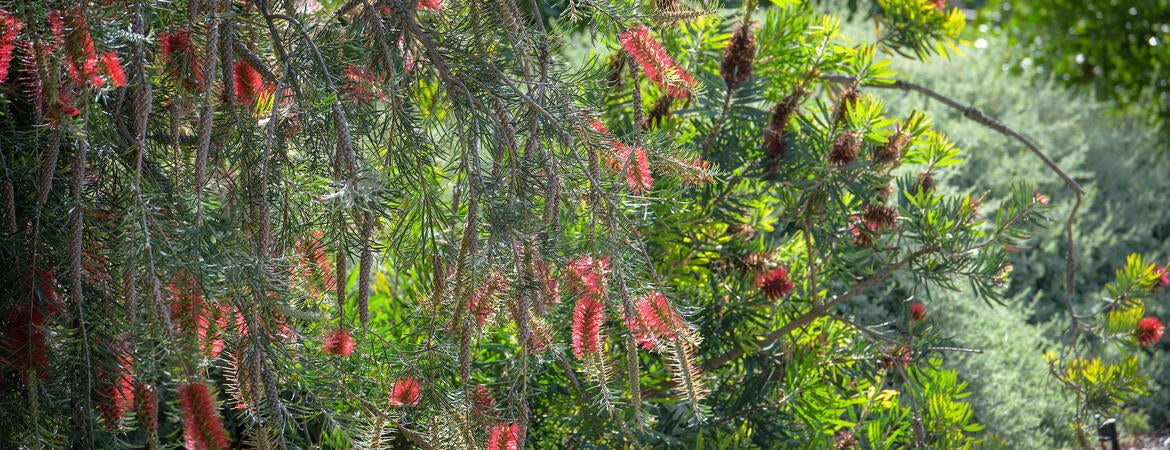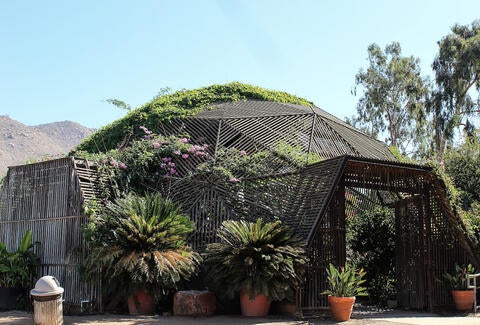
Sunday, Sept. 24, UC Riverside’s Botanic Gardens celebrates a major milestone — its 60th anniversary. Before looking forward to where this 40-acre campus gem is headed, here is a short look back at where it has been.
The idea for a UCR botanic garden was planted in the minds of UCR leadership in 1954, the year the campus opened. At that time, the grounds were mostly open shrubland, grasses and short woody plants common to the mountains of Riverside County.
“At that time faculty in the brand new Division of Biological Sciences, some from as far away as the midwestern U.S., were tasked with teaching California flora to students at the new university and realized they had no idea what plants grew in their new home state,” said Jodie Holt, director of the gardens and plant physiology professor emeritus.
To help faculty and students learn about local flora, the “Life Sciences Experimental Area” gardens for research and teaching took root in 1963. The first irrigation system was installed, native trees and shrubs were planted and labeled, and paved roads appeared.
In the 1970s, gardens director Louis Erickson installed specialty gardens, including the 3-acre subtropical fruit orchard featuring citrus, guavas, avocados, macadamias, and sapotes, also called marmalade trees, which hail from Central America.
Specialty theme gardens have sprouted throughout the grounds since that time. There is a rose garden with more than 300 old and new varieties including miniatures. An iris garden with more than 150 cultivars delights visitors with a rainbow of colors. The herb garden features aromatic, culinary and medicinal herbs from around the world. If you sit still long enough in the butterfly garden, one might land on your shoulder.
Holt is particularly proud of the relatively new Native American plants garden, developed with UCR’s Native American student programs.
Other garden areas are organized by geographical region. The recently renovated Australian garden features plants native to that country’s Mediterranean climate including Eucalyptus, Melaleuca, Grevillea, and others. “You can go to Australia right now without getting on an airplane,” Holt said.
One trip could take a visitor to South Africa, California’s Sierra Nevada foothills, the Mojave and Colorado deserts, and Latin America all on the same trip.
Fast forward to 2023, and the gardens are averaging 80,000 visitors a year. There’s something for everyone. Children love the turtle pond, while adults enjoy iconic rock formations like pepper rock, named for the pepper tree growing out of the boulder. “It’s also been called make-out rock. When the tree hasn’t been pruned, the rock is a more secluded place,” Holt said.
An educational mission is still at the forefront of activities at the gardens, where docents lead school tours for K-12 students and for adults, and both UCR and Riverside Community College host classes and lab sessions. Virtual tours of the gardens are also available via interactive, GIS story maps that can be done with a smartphone in person, or at home in pajamas.
Throughout the decades, all of these offerings have been realized by a small staff and more than 250 volunteers from the campus and surrounding community. “I’m in genuine awe at how far we’ve advanced to become a bona fide botanic garden,” Holt said.
Celebrations on all this progress begin Sunday, Sept. 24 with special Open Sunday hours from 8 am — 3:30 pm. The first 90 UCR students can take home a free house plant. Docent-led tours, free plants for new members, and a special pop-up shop will take place throughout the week. Details are available on the UCR events calendar.
Moving forward, there are plans to expand the collections, establish a wildflower forage ground for the new Native Bee Garden, and continue to offer events like bird walks, twilight tours, and hands-on workshops for avid and beginning gardeners. There are also plans to replace the garden’s unique geodesic dome, which has fallen into disrepair.
Those interested in visiting this living museum and treasure of the Inland Empire can get more information or plan a trip by visiting the gardens’ website. Celebrate 60 years of flora and fauna by visiting the collections, wandering over 4 miles of scenic trails, or just relaxing on a bench and taking it all in.




